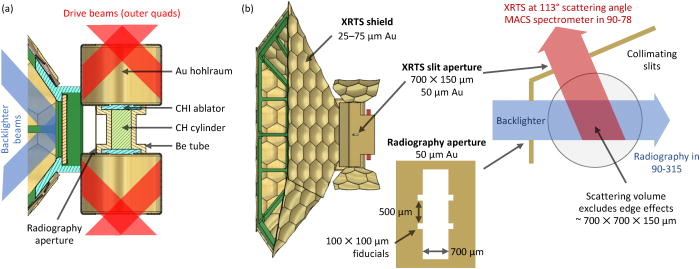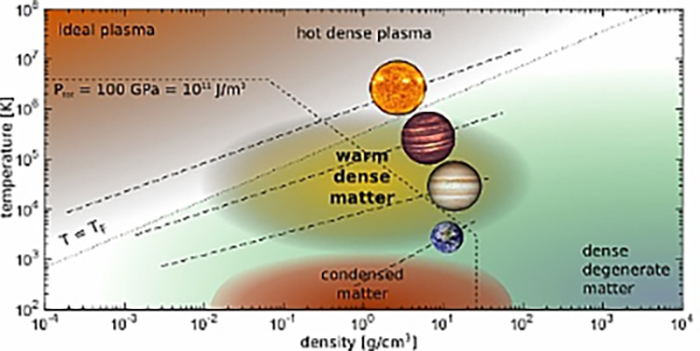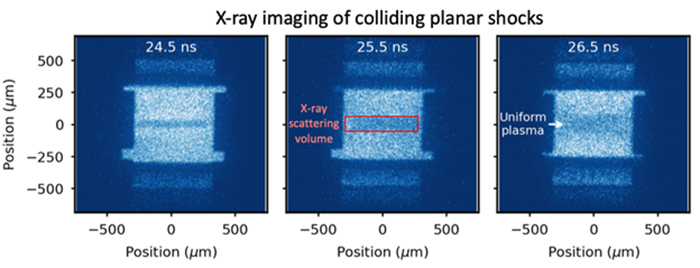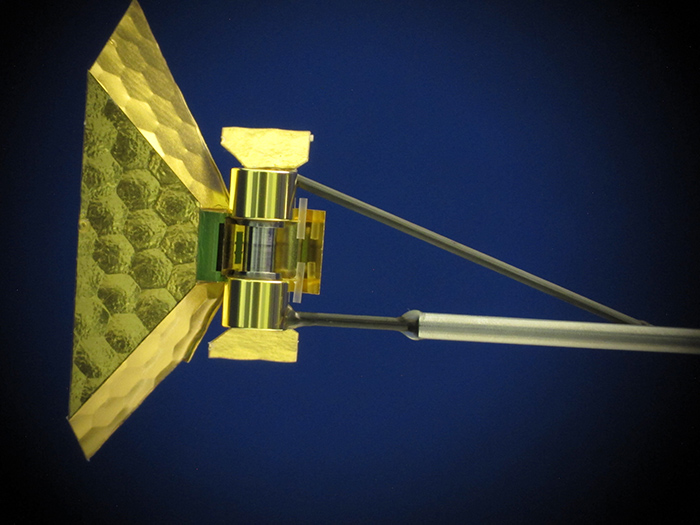To learn about the properties of materials under changing temperatures and pressures, researchers typically combine laboratory experiments with theoretical models and computer simulations. It's an iterative process: The models help in designing the experiments and interpreting the results, and the results "constrain," or fine-tune, the models so they can effectively guide future experiments.
But what if experiments alone could provide accurate, clear-cut data without needing to rely so heavily on the predictions of models?
That's the vision for a new experimental platform on NIF, the world's largest and highest-energy laser system, that promises to deliver precise measurements of the characteristics of warm dense matter (WDM), a state of matter exhibiting properties of both solids and plasmas.

Understanding the properties of the warm dense matter in planetary cores could help indicate if a planet could support life. Two planets, dubbed Teegarden's Star b and c, are shown in this artist's rendering orbiting an ultracool, red dwarf star less than 13 light-years from Earth. Discovered in 2019, the planets are both about 1.1 times the mass of Earth. Planet b, which completes one orbit around the star in just under five days, might be habitable despite its close proximity to its star. But Planet c, with an orbit of about 11½ days, falls well within the star's habitable zone, or the distance from the star that could allow liquid water on the planet's surface. Credit: NASA/JPL-Caltech
WDM is present in the interior of planets and some stars and is also produced in inertial confinement fusion (ICF) experiments. The new platform will provide unique, high-quality experimental data to guide the complex models required to simulate the properties of WDM.
Described in a Physics of Plasma paper published online on June 1 and selected as an "Editor's Pick," the colliding planar shocks (CPS) platform uses NIF to create two counter-propagating shock waves to produce uniform plasma conditions when they collide in the center of a cylindrical sample. Simultaneous x-ray Thomson scattering (XRTS) and x-ray radiography diagnostics measure a material sample's density, electron temperature, and ionization state in a single experiment, enabling high-precision equation-of-state measurements.

(a) Schematic showing the internal target components of the colliding planar shocks platform for simultaneous x-ray Thomson scattering (XRTS) and radiography measurements. Four NIF quads (16 beams) heat a backlighter foil, and the remaining outer quads (112 beams) drive the upper and lower gold (Au) hohlraums to launch planar shocks into the plastic (CH) target material. (b) View of the entire target showing the radiography and XRTS apertures used to restrict the probe volume to a 700×700-square-micron region in the center of the shock-compressed sample material. The large XRTS shield contains the expanding backlighter zinc plasma and blocks the direct line-of-sight between the plasma and the mono angle crystal spectrometer (MACS). CAD drawing credit: Scott Vonhof, General Atomics
"The key concept of the CPS platform is to create uniform plasma conditions so we don't rely on hydrodynamic simulations alone to interpret the results," said LLNL physicist Mike MacDonald, who led the project. "We use the simulations to set our diagnostic timing, however, to verify that the plasma we probe using x-ray scattering is uniform with simultaneous x-ray imaging."
"If the conditions we probe aren't uniform, we have to account for the range of conditions contributing to the measurement," he said. "That process introduces a model of the plasma conditions, usually from hydrodynamic code simulations, which can increase the uncertainty of the result. By creating a uniform volume of plasma we remove that step in the analysis, allowing us to more accurately probe the properties of WDM."
Obtaining x-ray scattering and radiography data in a single NIF shot is another distinctive feature of the CPS platform, said NIF Discovery Science program leader Bruce Remington. "You get density and temperature and ionization state," he said. "You measure almost everything that we care about" without having to rely so much on simulations to supply missing information.
"This is the first platform that I'm aware of where you can truly have the simultaneous capability of radiography and x-ray scattering," added Tilo Döppner, a co-author on the paper. "That's very powerful, and a big advancement in the field toward more precise plasma characterization and measurements."
Challenge to Modelers

Studying WDM, an exotic state of high-temperature, high-density material that makes up the cores of giant planets and brown dwarf stars, helps scientists gain a better understanding of the nature and evolution of the universe. It can also shed light on the chaotic conditions that can occur in high energy density (HED) and ICF experiments on NIF and other facilities, including studies in support of LLNL's stockpile stewardship mission.
Studying WDM, an exotic state of high-temperature, high-density material that makes up the cores of giant planets and brown dwarf stars, helps scientists gain a better understanding of the nature and evolution of the universe. It can also shed light on the chaotic conditions that can occur in high energy density (HED) and ICF experiments on NIF and other facilities, including studies in support of LLNL's stockpile stewardship mission.
WDM consists of strongly interacting particles with many competing and interconnected effects that challenge researchers to design models to simulate and study its behavior. Knowing the material's EOS—the relationship between density, temperature, and ionization—is essential to understanding its properties and performing high-fidelity simulations, according to the researchers.
"The equation of state drives everything," MacDonald said. "How much a material compresses, how fast shocks travel through the material, etc., all of which are critical to accurate simulations. Ionization models for WDM conditions are an area of particular interest because recent experiments have shown that our current models aren't sufficiently accurate."
“If your ionization model is wrong by a small amount, that can have a significant impact on the overall EOS model for a material.”
The CPS platform was initially developed while MacDonald was a postdoctoral scholar, first at UC Berkeley and then at LLNL. It was inspired by x-ray scattering measurements made using the NIF Gigabar Equation of State campaign that subjected a solid plastic sphere to pressures exceeding 100 megabars (100 million atmospheres) created by converging shocks driven by NIF's laser beams.

Simulations from the radiation hydrodynamics code xRAGE for initially solid plastic (CH), showing the density distribution (a) before and (b) after the two planar shocks collide in a CPS experiment. The distribution of the mass densities in the probed volume after the shock collision are shown in red in (c) along with the mass distribution from the 2013 NIF Gigabar x-ray scattering experiment in blue. The narrow distribution of mass densities probed in the CPS platform reduces the reliance on hydrodynamic simulations in interpreting the x-ray scattering data and improves measurement precision.
The Gigabar scattering experiment measured a wide range of plasma conditions, requiring comparisons to hydrodynamic modeling to interpret the results. The primary motivation for developing the CPS platform was to produce uniform volumes of WDM that can be precisely measured using simultaneous x-ray scattering and radiography.
XRTS measurements at the time showed that models describing the ionization balance in a hot dense plasma—the number of bound electrons compared to unbound electrons—underestimated the amount of ionization that occurs when material is subjected to extreme temperatures and pressures (see "NIF Experiment Challenges Standard Ionization Models").
"Whether you're trying to model astrophysics or ICF," MacDonald said, "if these models are wrong, you're building a house of cards. This (CPS platform) allows us to measure the equation of state to really understand the important physics of WDM in these extreme states—which can only be produced in these large volumes at NIF."

X-ray images collected using the CPS platform at three times from a single experiment. Shocks are driven from the top and bottom and collide in the center, creating a volume of WDM that can be probed with x-ray scattering. Apertures placed between the x-ray source, target, and the x-ray spectrometer restrict the scattering measurement to the uniform volume in the center.
Key elements of the CPS platform were derived from counter-propagating shock experiments conducted by Los Alamos National Laboratory (LANL). MacDonald worked closely with LANL's Carlos Di Stefano in designing the new platform.
Studying Exoplanets
Astrophysicists are keen to learn more about WDM because it could help shed light on the dynamics of planetary formation and the search for extraterrestrial life, Remington said. More than 5,000 exoplanets have been discovered, a subset of which are similar to Earth.
"If you have a terrestrial planet, even if it's bigger than ours," he said, "and you understand the warm dense matter conditions well enough to say, 'The interior must look like the following,' then you can predict if it has a magnetic field or not. If you don't have a magnetic field, you won't have biology."

Close-up of a target for the colliding planar shocks platform. The complex target was a joint effort by the target fabrication teams at LLNL and Los Alamos National Laboratory (LANL) led by LLNL's Rick Heredia.
WDM is also a factor during implosions in HED and ICF experiments, such as those that led to LLNL's achievement of ignition on NIF in December 2022.
"The conditions we are generating (on the CPS platform) are similar to in-flight conditions in ICF capsule implosions as they approach stagnation," Döppner said, "so you can actually test those plasma conditions in a much better controlled environment."
In addition, MacDonald said, a two-day Discovery Science campaign scheduled for next fiscal year will use the CPS platform to help improve understanding of the ionization state of the high-density carbon, or diamond, target capsules used in current high-yield ICF implosion designs (see "How NIF Targets Work"). Luke Fletcher from SLAC National Accelerator Laboratory will be the campaign's principal investigator.
"There are suspected issues with the models of the ionization state of carbon," MacDonald said. "It's a complicated integrated measurement. This platform gives us a way to isolate the ionization of those materials and measure them carefully (rather than) trying to measure them in an ICF shot."
The CPS platform "shows promise to become a workhorse for these types of measurements—for diamond, beryllium, lithium hydride, and so on," Döppner added. "There are a lot of ideas you can pursue based on this platform. It's only the beginning."
Participants in developing the new platform were MacDonald, Döppner, Heredia, Dan Kalantar, Suzanne Ali, Peter Celliers, Jim Gaffney, Alison Saunders, and Rich Zacharias from LLNL; Di Stefano, Kirk Flippo, Liz Merritt, Derek Schmidt, and Christopher Wilson from LANL; Fletcher and Siegfried Glenzer from SLAC; Vonhof from General Atomics; Rip Collins from the Laboratory for Laser Energetics at the University of Rochester; Dirk Gericke from the University of Warwick in the UK; Kraus from the University of Rostock and the Helmholtz-Centrum Dresden-Rossendorf in Germany; and Roger Falcone from UC Berkeley.
News from: https://lasers.llnl.gov/news/new-nif-experimental-platform-will-probe-warm-dense-matter


